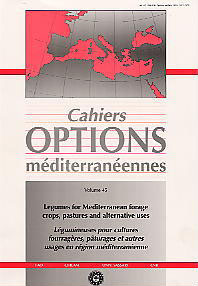| Article précédent | p. 287-291 | Article suivant |
Berseem growth response to different cutting regimes
Berseem clover (Trifolium alexandrinum L.) is an annual forage crop widely grown in Mediterranean environments. The accumulation of dry matter in the various plant organs, at a given growth stage, in forage legume species is a subject of biological and economic concern. The study was carried out during three growing seasons (1991-92, 1992-93 and 1993-94) at Foggia (southern Italy), with the aim of evaluating changes in the growth dynamics of one population of Egyptian (cv.'Giza 10') as well as Italian (cv.'Sacromonte') origin using field-grown plants under several cutting regimes. The harvest treatments were applied at three developmental stages of the plant: sixth internode elongation, early flowering and physiological maturity of seeds (treatments A, B and C, respectively). Seasonal growth pattern, determined as dry matter accumulation, was greatly influenced by cutting regimes. In treatment C, the maximum value (21.6 g plant-1 in the mean) was reached at about 250 days after sowing.
- [ Télécharger ]
- [ Exporter la citation ]
Vous pouvez télécharger la citation au format :
- [ Imprimer ]
- [OMC45]




